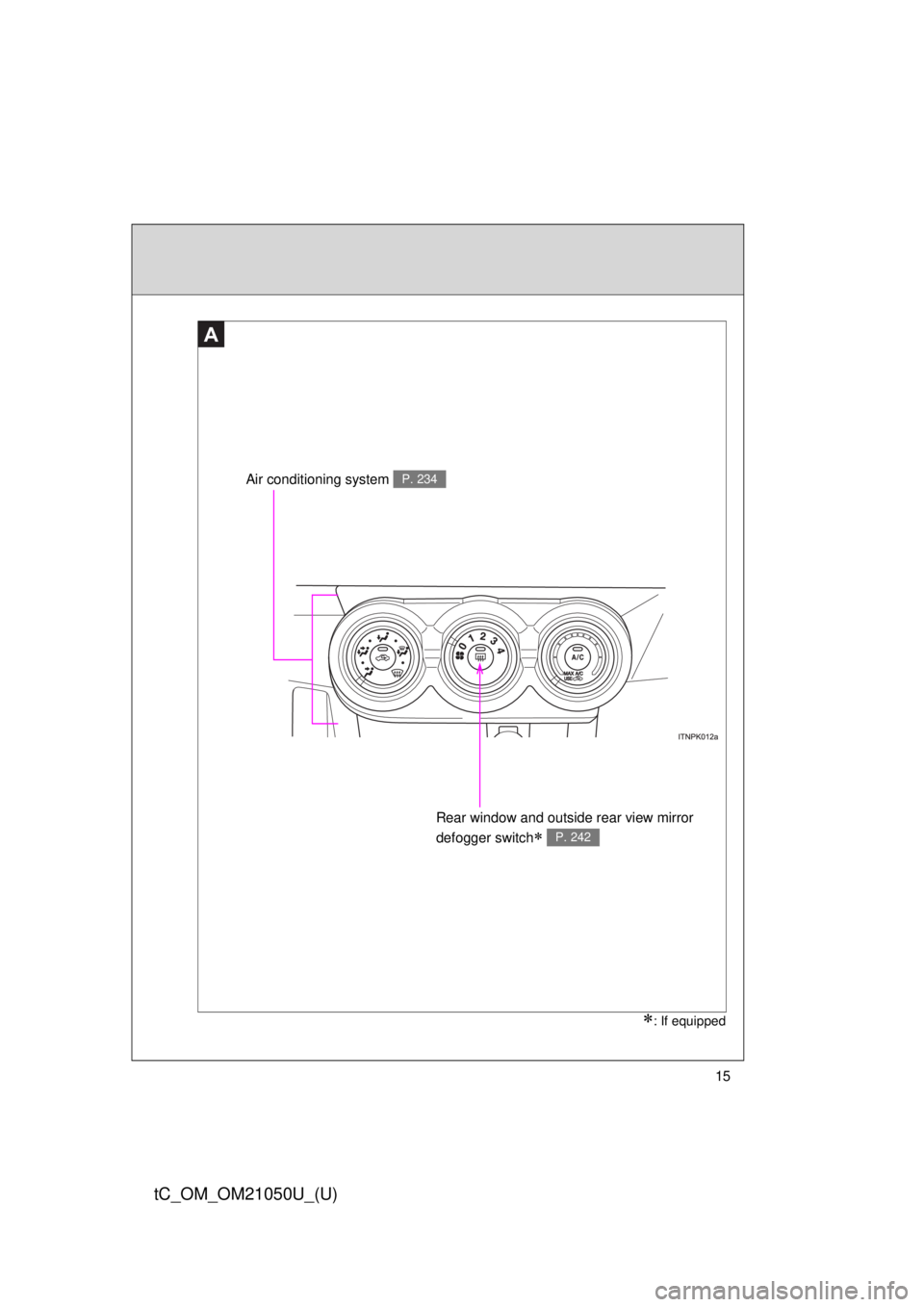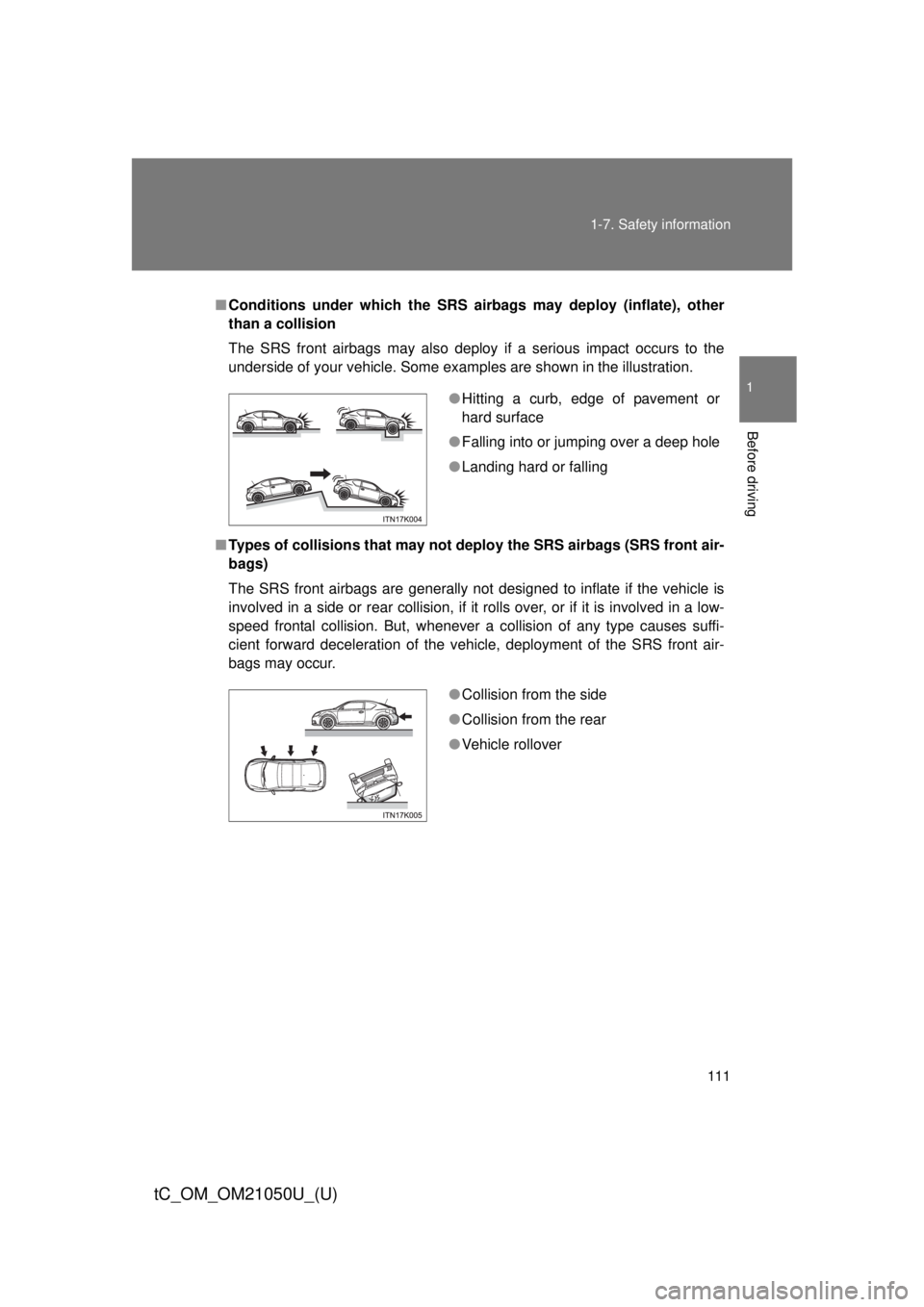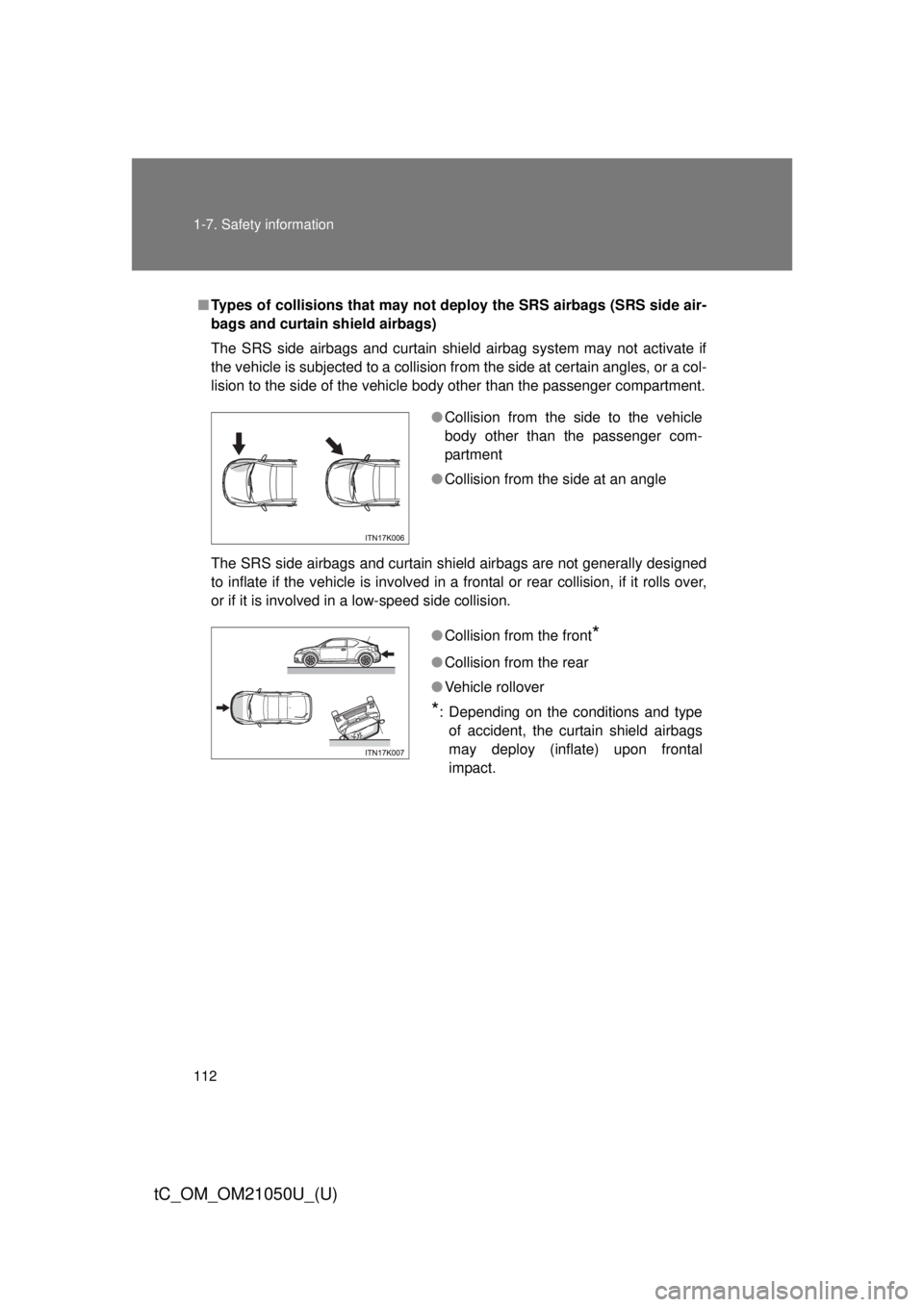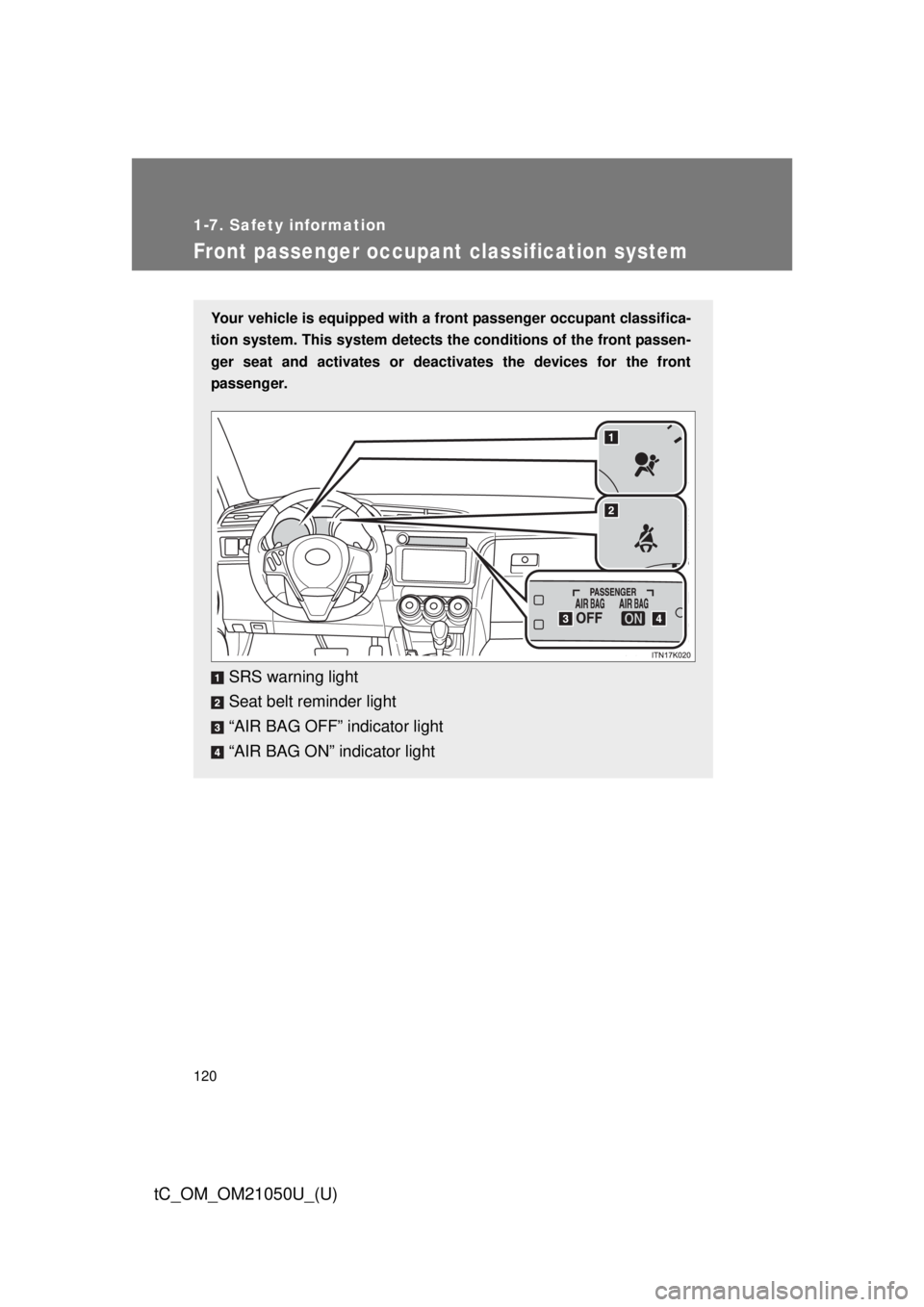air condition TOYOTA tC 2013 Owners Manual (in English)
[x] Cancel search | Manufacturer: TOYOTA, Model Year: 2013, Model line: tC, Model: TOYOTA tC 2013Pages: 484, PDF Size: 9.41 MB
Page 1 of 484

TABLE OF CONTENTS
1
tC_OM_OM21050U_(U)
1Before drivingAdjusting and operating features such as door locks,
mirrors, and steering column
2When drivingDriving, stopping and safe-driving information
3Interior
featuresAir conditioning as well as other interior features for a
comfortable driving experience
4Maintenance
and careCleaning and protecting your vehicle, performing do-it-
yourself maintenance, and maintenance information
5When trouble
arisesWhat to do if the vehicle needs to be towed, gets a flat
tire, or is involved in an accident
6Vehicle
specificationsDetailed vehicle information
7For ownersReporting safety defects for U.S. owners, and seat belt
and SRS airbag instructions for Canadian owners
IndexAlphabetical listing of information contained in this
manual
Page 3 of 484

1
2
3
4
5
6
7
3
tC_OM_OM21050U_(U)
2-3. Operating the lights and Windshield wipers
Headlight switch .................. 197
Windshield wipers and washer .............................. 201
Rear window wiper and washer .............................. 205
2-4. Using other driving systems Cruise control ...................... 208
Driving assist systems ........ 212
2-5. Driving information Cargo and luggage ............. 217
Vehicle load limits ............... 222
Winter driving tips ............... 223
Trailer towing ...................... 229
Dinghy towing (automatic transmission) .................... 230
Dinghy towing (manual transmission) .................... 231
3-1. Using the air conditioning system and defogger
Air conditioning system ....... 234
Rear window and outside rear view mirror
defoggers .......................... 242 3-2. Using the audio system
Using the AUX port/USB port ................................... 243
Using the steering wheel audio switches.................. 244
Using the microphone ........ 245
3-3. Using the interior lights Interior lights list ................. 246
• Personal/interior light main switch ...................... 247
• Personal/interior lights...... 248
• Interior light ...................... 249
3-4. Using the storage features List of storage features ....... 251
• Glove box ......................... 252
• Console box ..................... 253
• Auxiliary box ..................... 254
• Cup holders ...................... 254
• Bottle holders ................... 255
3-5. Other interior features Sun visors........................... 256
Vanity mirrors ..................... 257
Clock .................................. 258
Power outlet ....................... 259
Seat heaters ....................... 260
Sunshades ......................... 262
Assist grips ......................... 264
Floor mat ............................ 265
Luggage compartment features ............................ 267
3Interior features
Page 15 of 484

15
tC_OM_OM21050U_(U)
Air conditioning system P. 234
Rear window and outside rear view mirror
defogger switch
P. 242
A
: If equipped
Page 43 of 484

43
1-2. Opening, closing and locking the doors
1
Before driving
tC_OM_OM21050U_(U)
■
Conditions aff ecting operation
The smart key system uses weak radio waves. In the following situations,
the communication between the electronic key and the vehicle may be
affected, preventing the smart key system and wireless remote control from
operating properly. (Ways of coping P. 405)
● When the electronic key battery is depleted
● Near a TV tower, electric power plant, gas station, radio station, large dis-
play, airport or other facility that generates strong radio waves or electri-
cal noise
● When carrying a portable radio, ce llular phone, cordless phone or other
wireless communication device
● When the electronic key is in contact with, or is covered by the following
objects
• Cards to which aluminum foil is attached
• Cigarette boxes that have aluminum foil inside
• Metallic wallets or bags
• Coins
• Hand warmers made of metal
• Media such as CDs and DVDs
● When multiple electronic keys are in the vicinity
● When another wireless key (that emits radio waves) is being used nearby
● When carrying or using the electronic key together with the following
devices that emit radio waves
• Another vehicle’s electronic key
• A wireless key that emits radio waves
• Personal computers or personal digital assistants (PDAs)
• Digital audio players
• Portable game systems
● If window tint with a metallic content or metallic objects are attached to
the rear window
Page 52 of 484

52 1-2. Opening, closing and locking the doors
tC_OM_OM21050U_(U)
■Security feature
If a door is not opened within approximately 60 seconds after the vehicle is
unlocked, the security feature automatically locks the vehicle again.
■ Conditions affecting operation
The wireless remote control function may not operate normally in the follow-
ing situations:
Vehicles without a smart key system
● Near a TV tower, radio station, electr ic power plant, airport or other facil-
ity that generates strong radio waves
● When carrying a portable radio, cell ular phone or other wireless commu-
nication devices
● When multiple wireless keys are in the vicinity
● When the wireless key is in contact with, or is covered by, a metallic
object
● When a wireless key (that emits radio waves) is being used nearby
● When the wireless key has been left near an electrical appliance such as
a personal computer
Vehicles with a smart key system
P. 4 3
■ If the wireless remote control does not operate properly (vehicles with
a smart key system)
Locking and unlocking the doors: Use the mechanical key. ( P. 405)
■ Key battery depletion
Vehicles without a smart key system
If the wireless remote control function does not operate, the battery may be
depleted. Replace the battery when necessary. ( P. 330)
Vehicles with a smart key system
P. 4 7
Page 110 of 484

110 1-7. Safety information
tC_OM_OM21050U_(U)
■SRS airbag deployment conditions (SRS front airbags)
● The SRS front airbags will deploy in the event of an impact that exceeds
the set threshold level (the level of force corresponding to an approxi-
mately 12 - 18 mph [20 - 30 km/h] frontal collision with a fixed wall that
does not move or deform).
However, this threshold velocity will be considerably higher if the vehicle
strikes an object, such as a parked vehicle and sign pole, which can move
or deform on impact, or if the vehicle is involved in an underride collision
(e.g. a collision in which the front of the vehicle “underrides”, or goes
under, the bed of a truck, etc.).
● Depending on the type of collision, it is possible that only the seat belt
pretensioners will activate.
● The SRS front airbags for the front passenger will not activate if there is
no passenger sitting in the front passenger seat. However, the SRS front
airbags for the front passenger may deploy if luggage is put in the seat,
even if the seat is unoccupied. ( P. 120)
■ SRS airbag deployment conditions (SRS side airbags and curtain
shield airbags)
● The SRS side and curtain shield airbags will deploy in the event of an
impact that exceeds the set threshold level (the level of force corre-
sponding to the impact force produced by an approximately 3300 lb.
[1500 kg] vehicle colliding with the vehicle cabin from a direction perpen-
dicular to the vehicle orientation at an approximate speed of 12 - 18 mph
[20 - 30 km/h]).
● The SRS curtain shield airbags may also deploy in the event of a severe
frontal collision.
Page 111 of 484

111
1-7. Safety information
1
Before driving
tC_OM_OM21050U_(U)
■
Conditions under which the SRS airbags may deploy (inflate), other
than a collision
The SRS front airbags may also deploy if a serious impact occurs to the
underside of your vehicle. Some examples are shown in the illustration.
■ Types of collisions that may not de ploy the SRS airbags (SRS front air-
bags)
The SRS front airbags are generally not designed to inflate if the vehicle is
involved in a side or rear collision, if it rolls over, or if it is involved in a low-
speed frontal collision. But, whenever a collision of any type causes suffi-
cient forward deceleration of the vehicle, deployment of the SRS front air-
bags may occur.
● Hitting a curb, edge of pavement or
hard surface
● Falling into or jumping over a deep hole
● Landing hard or falling
●Collision from the side
● Collision from the rear
● Vehicle rollover
Page 112 of 484

112 1-7. Safety information
tC_OM_OM21050U_(U)
■Types of collisions that may not de ploy the SRS airbags (SRS side air-
bags and curtain shield airbags)
The SRS side airbags and curtain shield airbag system may not activate if
the vehicle is subjected to a collision from the side at certain angles, or a col-
lision to the side of the vehicle body other than the passenger compartment.
The SRS side airbags and curtain shield airbags are not generally designed
to inflate if the vehicle is involved in a frontal or rear collision, if it rolls over,
or if it is involved in a low-speed side collision.
● Collision from the side to the vehicle
body other than the passenger com-
partment
● Collision from the side at an angle
●Collision from the front*
●Collision from the rear
● Vehicle rollover
*: Depending on the conditions and type
of accident, the curtain shield airbags
may deploy (inflate) upon frontal
impact.
Page 120 of 484

120
1-7. Safety information
tC_OM_OM21050U_(U)
Front passenger occupant classification system
Your vehicle is equipped with a front passenger occupant classifica-
tion system. This system detects the conditions of the front passen-
ger seat and activates or deactiv ates the devices for the front
passenger.
SRS warning light
Seat belt reminder light
“AIR BAG OFF” indicator light
“AIR BAG ON” indicator light
Page 121 of 484

121
1-7. Safety information
1
Before driving
tC_OM_OM21050U_(U)
Conditions and operation of the
front passenger occupant clas-
sification system
■ Adult
*1
■Child*3 or child restraint system*4
Indicator/
warning light “AIR BAG ON” and
“AIR BAG OFF” indicator lights“AIR BAG ON”
SRS warning light Off
Seat belt reminder light Flashing
*2
DevicesFront passenger airbag
Activated
Side airbag on the front
passenger seat
Curtain shield airbag in the front passenger side
Front passenger knee airbag
Front passenger’s seat belt pretensioner
Indicator/
warning light “AIR BAG ON” and
“AIR BAG OFF” indicator lights
“AIR BAG OFF”
*5
SRS warning light Off
Seat belt reminder light Flashing
*2
DevicesFront passenger airbag Deactivated
Side airbag on the front passenger seat Activated
Curtain shield airbag in the front
passenger side
Front passenger knee airbag Deactivated
Front passenger’s seat belt pretensioner Activated